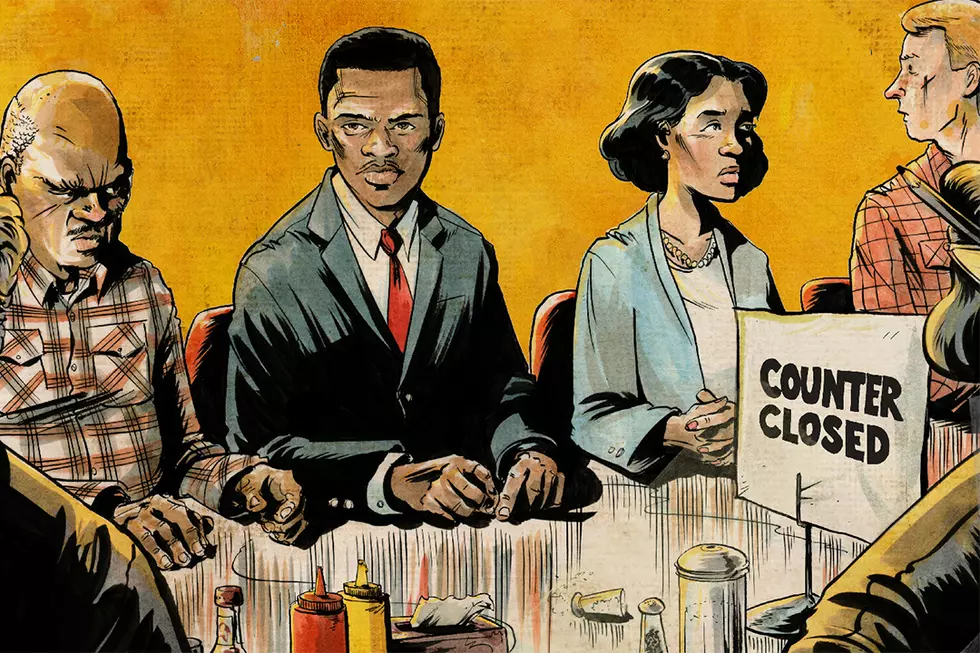![‘The Influencing Machine’ Shows the Medium Isn’t the (Entire) Message [Review]](http://townsquare.media/site/622/files/2012/05/1stamendment.jpg?w=980&q=75)
‘The Influencing Machine’ Shows the Medium Isn’t the (Entire) Message [Review]

In last month's The Goon #39, writer/artist Eric Powell follows up a devastating satirical takedown of modern superhero comics --specifically DC's New 52 line -- with an essay titled "Where's Our Harry Potter?" Powell passionately argues that comics should tell, and must tell, more than just superhero stories to survive. Powell was pretty clearly talking about fiction, but the entire time I was reading his essay, I couldn't help but think of a book I read last year (which, incidentally, was released earlier this month in paperback from W. W. Norton & Company), Brooke Gladstone and Josh Neufeld's The Influencing Machine, an in-depth examination of the history and impact of mass media. I've never read another comic like it, but I hope I get the opportunity to read many more.

What's fascinating about the book isn't that it's nonfiction -- after all, we have graphic novels like Blankets, Persepolis, American Splendor, the graphic adaptation of The 9/11 Report and many others to hold up as examples of accomplished, narrative nonfiction. It isn't even so much that the book lacks narrative, though it has one in only the loosest sense of the word, in that it does gradually move from the history of the press through present day media and up to the future of communication. And again, there are numerous examples of great comics without narrative.It's that Gladstone, co-host of NPR's On the Media, and Neufeld, who has illustrated American Splendor stories and authored the acclaimed A.D.: New Orleans After the Deluge, take a topic that could easily lend itself to a volume of nothing but dry interviews or historical facts presented in a textbook-like fashion and make it eminently engaging.
Though Gladstone and Neufeld depict a handful of events, The Influencing Machine is really a collection of ideas, dissected: Describing them, analyzing them, delving into differing opinions about them, and eventually assembling them into an overarching theory of the purpose and limits of media.

In her acknowledgements, Gladstone writes: "I wanted to write a comic book long before I wanted to write a book about the media. I thought writing in bubbles would be easier, more like radio. It was more like radio, but it wasn't easier." She goes on to explain that the book was something of a puzzle for her to put together, since, for her, narrative is such an important part of comics.
"Graphic nonfiction was not a suitable genre for a book about ideas, because ideas are hard to convey without a lot of words," she writes. That was her challenge.
Indeed, I can only think of one other book that presents ideas similar to the way The Influencing Machine does, and that's Scott McCloud's Understanding Comics (notably, she says McCloud's book was a big influence). The main aspect of the presentation both books share is that they include a narrator character who is also the author as his/herself, speaking directly to the reader.
Gladstone goes one step beyond McCloud, though, presenting the numerous interviews she conducted for the book with each interviewee drawn in as a character to explain his or her point of view. It's as though Gladstone brought in this person (or in some cases, an historical figure she's quoting) in to talk to us for just a second before she's on to the next point. Seeing a face to go with the words adds a real personality and warmth to the reportage.
In the section about the so-called "Goldilocks Number" -- a figure that pops up in all kinds of reporting because it's believable and often repeated by sources, if not really accurate -- Gladstone speaks to Ken Lanning, a consultant on crimes against children. If these quotes weren't accompanied by these images of a shrugging, bald man in a loud jacket, would you think of them the same way?

Much of why this works can be laid at the feet Neufeld, whose style here has a cartoonish touch to it, but is awash with really nice details. He does great caricatures (his depiction of Helen Thomas, the famous White House gallery reporter, is both accurate and hilarious) and pulls off pitch-perfect facial expressions to match the little snippets of what's being said. Plus, he does a terrific job of integrating Gladstone into panels appropriate to the topic, like putting her in early-1900s period clothing, or inserting her face into an homage to a handful of famous paintings or photos.
I should point out that Gladstone and Neufeld don't quite manage to fit everything into comics panels. Every eight to 10 pages, Gladstone shifts gears to another idea or another era, and often those shifts are accompanied by a page or two of text with a segue and some explanation. It seems that Gladstone never quite nailed how to introduce an idea graphically, though she found her footing quite well when it came to fleshing out and providing examples of those ideas.
Examples and comparisons are a huge part of what give Gladstone's observations visual punch. For instance, in her discussion of all the different types of bias, she discusses how biases can be combined. Case in point: The toppling of the Saddam Hussein statue in April 2003 was a combination of visual and narrative bias, she states. The artwork that accompanies that statement? The statue coming down, but with Gladstone's head on it.

In another section, this one about objectivity, Gladstone compares the concept to a doughnut: The hole is the sphere of consensus, the actual doughnut -- what much of journalism rests on -- is controversy, or issues that people in a society haven't totally agreed upon. Around the doughnut is the fringe, or stuff mainstream society determines just isn't worth talking about. This metaphor would work without images, but with it, as Neufeld draws Gladstone holding up the doughnut, tossing it around, taking a bite out of it, there's a much stronger effect.
If Gladstone had decided to sit down and write a history and examination of media that makes all the same points but wasn't a comic -- if it was all text -- I can't imagine it would have anything close to the tone of The Influencing Machine. Even the most casually written books about academic topics like this tend to feel like lectures; The Influencing Machine feels like a conversation.
Only the medium of comics can really do that. It kind of makes you wonder what else comics might be able to do, if we broaden our horizons, even well beyond our Harry Potter.
More From ComicsAlliance









